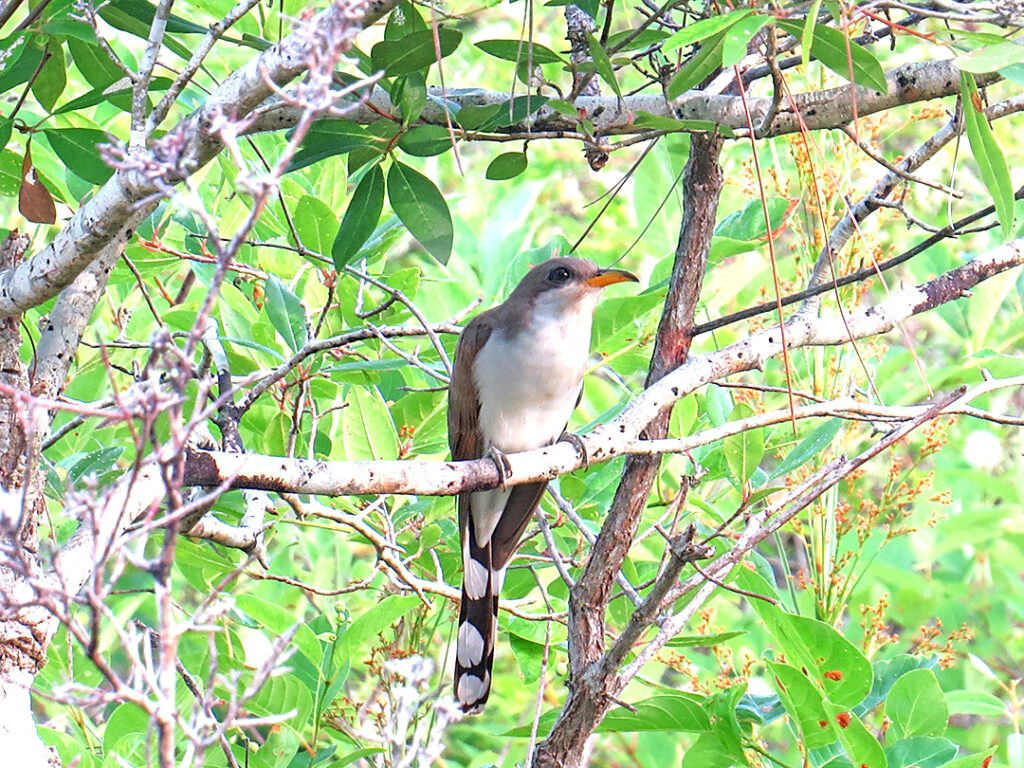Walking on Tram Road

By DON MORROW
I walked out Tram Road at St. Marks National Wildlife Refuge last week, starting out under light fog just before sunrise.
Tree frogs were calling, along with Northern Bobwhites, Common Grackles, and a pair of duetting Northern Cardinals. Things were slow at first, but then I started seeing Common Yellowthroats, Yellow-throated Warblers and Blue-gray Gnatcatchers.
I was hunting for Eastern Wood-Pewee, one of the refuge’s summer flycatchers. Because my geriatric ears can no longer detect softer, higher-pitched bird calls, I would need to see a pewee and I had planned to walk a mile down the road to search for them.
I can still hear most birds and I picked up the sounds of Red-bellied and Pileated Woodpecker, the distant gowping call of a Yellow-billed Cuckoo, as well as the sonorous cooing of Mourning Doves.
Pewees like pine woods. They sit on exposed branches as they wait for flying insects and frequently change position. I was scanning the woods as I walked, looking for movement or silhouetted birds. Several times I got excited, but when I got my binoculars on a moving bird, I found only an Eastern Bluebird, Downy Woodpecker or more gnatcatchers.
It wasn’t bad birding. I heard Yellow-throated Vireo, Green Heron, Summer Tanager and Yellow-breasted Chat. A Wood Duck flew by and I found a Red-cockaded Woodpecker working its way up the trunk of a pine.
Just over a mile down the road, I turned back. By this time the fog had burned off and the sun was fully out. It was beginning to warm up.
Walking back, I was getting mostly the same species, but added White-eyed Vireo and watched a rather bedraggled adult Carolina Chickadee feeding a plump juvenile bird.
I heard a cuckoo calling from somewhere just off the road. I watched as it flew in and landed on a branch. It was facing a second cuckoo. They seemed to kiss, but I was likely seeing a male feeding a female. The second bird flew to a nearby branch, pointed her tail downward and then raised and lowered her tail several times. This is a typical pre-mating display for a female cuckoo.
The male bird flew down to a shrub about 10 feet from me and sat there for a few minutes before flying away. The pair had not attempted to mate. Perhaps they were early in pair formation or maybe my presence had put them off.
Yellow-billed Cuckoos are slender foot-long birds, brown above and white below with rufous-edged flight feathers and prominent white spots on the underside of their tails. They are summer residents and breeders at St. Marks and winter down in the Amazon basin.
Cuckoos are usually difficult to see as they hunt for prey, moving slowly through the canopy from branch to branch. They eat large insects – caterpillars, beetles, and grasshoppers. They will also eat lizards and tree frogs and late in the season supplement their diet with fruit.
I never did find a pewee that morning, but I was not disappointed. There are pewees out there. They nest in the pines along Tram Road every summer. I will find them on another summer walk.
The excitement of Spring migration is over, but there is still a lot happening down at St. Marks. You should come down and go birding.
Don Morrow can be reached at donaldcmorrow@gmail.com.


